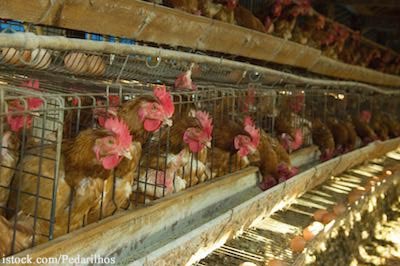The Center for Food Safety (CFS) has issued a white paper that scolds the USDA for stalling poultry animal welfare regulations. Most egg and poultry operations would not be affected by the increased welfare standards. The USDA analysis of economic impact is “faulty”, according to CFS.
 The paper states that the largest organic farms are not following standard animal welfare practices. USDA’s own analysis showed that the welfare improvements would affect the largest organic egg producers so much that they would stop organic production. Those five farms, out of 586 organic poultry farms in the country, claim the increases in cost because of increased regulations will bankrupt them.
The paper states that the largest organic farms are not following standard animal welfare practices. USDA’s own analysis showed that the welfare improvements would affect the largest organic egg producers so much that they would stop organic production. Those five farms, out of 586 organic poultry farms in the country, claim the increases in cost because of increased regulations will bankrupt them.
Bringing larger broiler producers into compliance would result in a 2.5% increase in price. Impact on small and medium organic egg and broiler producers would be “negligible”. The baseline fixed cost for small, mid-sized, and large producers are $40/bird for large operations, $32/bird for medium sized, and $29 per bird for small operations. The USDA’s analysis found that the cost for small and medium operations would be unchanged, while they said the cost per bird for large operations “jumps to $295 per bird.” The white paper states “these figures seem grossly inaccurate.”
Unfortunately, unnatural lighting, tight stocking, few and small doors leading to the outside, cement porches instead of pasture, and limited to no access to the natural environment are the “norm” in many organic poultry productions. Using these conventional practices in organic farming violates the Organic Food Production Act.
Animal welfare is a basic principle of organic production. The National Organic Standards Board (NOSB) submitted recommendations on animal welfare and specific requirements for poultry in 2002, 2009, and 2011. The USDA has done nothing about these recommendations for at least two years.
Animal welfare affects nutrition, food quality, and food safety. Higher-welfare chicken eggs, for instance, have more omega-3 fatty acids than eggs from chickens raised conventionally and housed indoors. Grass fed chickens have eggs with higher beta-carotene. Chickens fed clover have the highest vitamin E levels.
And animals raised in factories are kept in unsanitary conditions that lead to food-borne illness. In some large poultry farms, hens are covered in liquid manure. Decaying, dead hens are left on floors, in cages, and on cage ledges and tops. And stressed animals are more likely to harbor pathogenic bacteria, that can be passed on to consumers.
While consumers of organic foods expect higher quality, the realities of organic production do not always meet those expectations. Implementation of NOSB recommendations will prohibit practices such as de-beaking and dubbing (removal of poultry combs and wattles) and will ensure that laying bends have at least two squares feet of space per bird.
CFS says that USDA is allowing “a few large egg producers – the one per cent – to hold the organic poultry industry – the ninety-nine percent – hostage by not allowing the implementation of baseline animal welfare regulations according to the white paper. Much of the industry is in compliance with NOSB recommendations, and many exceed the minimal requirements. ”
So the USDA ignores expectations and ethics that are inherent in organic purchases, uses economic models that do not mimic market behavior, does not discuss benefits to small and mid-sized producers, and uses “representative operations” instead of scientific basis for stalling regulations. All at the cost of animal welfare and human health for the sake of a few large poultry producers.




